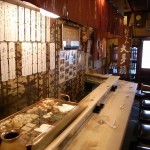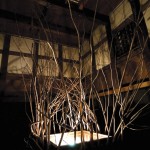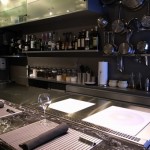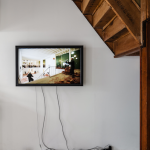東京スカイツリーTokyo Sky Tree
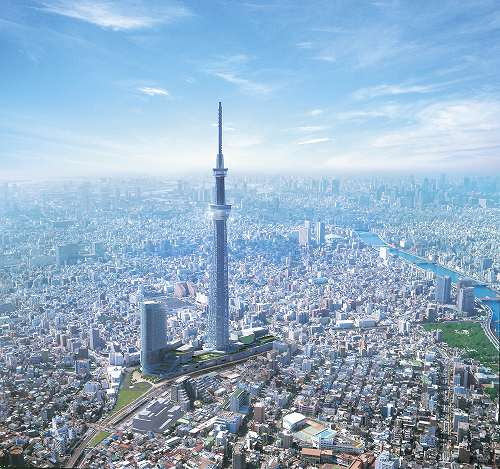
Tokyo Sky Tree imaginary picture by Yoshikazu Takada
In a modern, innovative city whose only constant is change, Tokyo has found the perfect symbol to represent its hip, dynamic spirit as a city – the new Tokyo Sky Tree, scheduled to complete construction by December 2011モダンで革新的な街。そこでは唯一変わり続けるということだけが変わらない。東京は、そのスマートでダイナミックな精神を象徴するにふさわしいシンボルを手に入れた。東京スカイツリーは2011年の12月に竣工し、2012年の春にオープンする予定だ。浅草の粋な下町から東に1キロ、伝統ある街、相撲で知られる両国から北東へ2キロ、東京の豊富な歴史が、発展しつづける現在と未来に結びつく地点、墨田区押上業平橋地区に誕生する。
![]()
自立式電波塔としては世界一の高さになるよう設計されたタワーは634メートルに達し、テレビ業界にも極めて重要な変革をもたらす。2011年7月までに、現在のアナログ放送が、ここから発信されるデジタル放送に完全移行するのだ。すべての建物を眼下に見下ろすこの新しいタワーは、移動通信機器むけのデジタル放送「ワンセグメント(ワンセグ)」放送の改良という役目も担っている。東京は、このタワーの建造を通じて、先端技術とユニークな文化の今を、その記憶とルーツを内包するエリアから、日本の他地域のみならず、世界中に広めていくつもりだ。
![]()
この大きな意味を持つ東京のシンボルは、設置場所の歴史・文化・地理とリンクする象徴的な外観を伴っている。三角形の足元は、重なり合う隅田川・荒川・交通の東西軸を表現している。三脚を見てもわかるように、3というのは安定を得られる最小の単位であり、これは地震の多い都市においても、タワーの安定性をしっかりと保証するものである。足元から頂部へと視線を移していくにつれて、三角形から円形へと変化していくシルエット、そして、見る場所によって変わるタワーのさまざまな表情からも、非常にクリエイティブかつ先進的な考えのもとに建てられたランドマークだということがわかるだろう。しかしながら、日本の流儀にのっとる建築家達は、目新しさが如何にはかないかということも忘れてはいない。「そり」(凹形のカーブ)や「むくり」(凸形のカーブ)など、日本伝統の建築術を全体のデザインの中に採用しているのはそのためだ。
![]()
東京スカイツリーの基調色である白は日本の伝統美にさらなる敬意を示すものだ。江戸の精神的なシンボルである、雪を頂く富士山や、火消しの纏(まとい)、祭りに使われるのぼり旗などに代表されるように、白は日本の清らかさや神聖さの概念から切り離すことができない。また、時代に左右されない色でもある。可能性と変革の象徴であり、東京の変わり続ける風景の物語が描かれる、真っ白なキャンバスのようでもある。
![]()
展望ロビー外周のガラスで覆われた空中回廊は、高度450メートルに設けられ、世界一高い歩道と、眼下に広がる大都会の息をのむような美しいパノラマを提供する。世界一高い展望タワーは、東京の多面性を表すふたつのオペレーションによって毎日交互にライトアップされる。それは、東京をその上に育くみ、互いに調和するふたつの基礎的概念である、洗練された江戸市民の精神「粋」と、理想的な優雅さと宮廷的な上品さを表す日本の伝統美学「雅」を反映したものである。
![]()
東京スカイツリー
住所:東京都墨田区押上1丁目1-13
開業:2012年春(予定)
TEL:03-3621-5670(東武タワースカイツリー株式会社)
http://www.tokyo-skytree.jp
![]()
Text: Bonnie Oeni
Translation: Kazuyuki Yoshimura and open in the spring of 2012. Located in the Narihirabashi/Oshiage area of Sumida Ward, about 1km east of the quaint shitamachi (downtown) area of Asakusa and 2km northeast of Ryogoku, the traditional town famous for sumo wrestling, the new tower stands at a focal point, connecting Tokyo’s rich past to its expanding present and future.
![]()
Designed to be the tallest free-standing tower in the world, the tower will reach 634m, and also marks pivotal change in the television industry, with a complete move from current analog broadcasting to digital broadcasting from this tower by July 2011. The new tower also hopes to improve transmissions for ‘one-segment broadcasting (one-seg)’, the digital broadcasting service for mobile devices, as it will stand above every other building. Through the construction of this tower, Tokyo’s ambition is to have the latest information about its cutting-edge technology and distinctive culture radiate out to the rest of the city, as well as to the world, while standing firm in a place that embodies its memories and roots.
![]()
This significant symbol of Tokyo is accompanied by iconic architectural work that is linked to its geography, culture and history. With the foot shaped as a triangle, the idea is representative of its location – the triangular interlocking shown by the Sumida River, Ara River and the east-west axis of traffic. As 3 is the smallest unit of stability, as seen in the case of tripods, this consideration is also a confident nod to the tower’s promise of stability in an earthquake-prone city. The base form of the tower also changes from triangular to circular if you shift your gaze from the bottom towards the top, and the different appearances that the tower seems to have depending on where you look makes this an extremely creative and forward-looking landmark. Yet, in true Japanese style, the architects do not abandon history for fleeting novelty, and have placed touches of traditional Japanese architecture, such as the ‘sori’ (concave curves) and ‘mukuri’ (convex curves) in the design of the silhouette.
![]()
The white colour of the Tokyo Sky Tree further pays tribute to traditional Japanese aesthetics. White is associated with Japanese purity and sanctity, best represented in the snow-capped Mt. Fuji, as well as in the firemen’s matoi and festival nobori banners, spiritual symbols of the old town of Edo. White is also a timeless colour, representative of possibility and change, like that of a blank canvas on which the story of Tokyo’s changing landscape can be painted.
![]()
A glass-covered sky walkway around the observatory lobby built at an altitude of 450m also promises the world’s highest walk with a beautiful, breathtaking panoramic view of the sprawling metropolis. The world’s tallest observatory tower will be lit up by two operations that will alternate every other day, to represent the multi-faceted faces of Tokyo. The lighting is inspired by Iki, the spirit held by the urbane commoners of Edo, and Miyabi, a traditional Japanese aesthetic ideal embodying elegance and courtly refinement, reflecting the two foundations, existing in harmony, on which Tokyo was built.
![]()
Tokyo Sky Tree
Address: 1-1-13 Oshiage, Sumida-ku, Tokyo
Open: Spring of 2012
Tel: 03-3621-5670
http://www.tokyo-skytree.jp
![]()
Text: Bonnie Oeni东京天空树
地址:東京都墨田区押上1丁目1-13
为了完成:2012年春天
电话:03-3621-5670(东武天空塔树有限公司)
http://www.tokyo-skytree.jp
![]()
